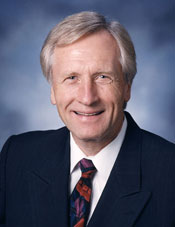| Wendell Roelofs |

|

"Decoding Chemical Signals from Insects to Elephants"

Dr. Wendell Roelofs
Liberty Hyde Bailey Professor of Insect Biochemistry
New York State Agricultural Experiment Station
Cornell University
Building 003 Auditorium
April 20, 2005
10:30 AM
Dr. Wendell Roelofs received his Bachelor's degree in chemistry at Central College of Pella, Iowa in 1960, and his Ph. D. in organic chemistry at Indiana University in 1964. Following a brief NIH postdoctoral fellowship at MIT, he joined the faculty at Cornell University where he became the Liberty Hyde Bailey Professor of Insect Biochemistry in 1976, a position he still holds today. Dr. Wendell Roelofs has received worldwide recognition for his pioneering research in the field of insect chemical communication. He made major breakthroughs in the chemical identification, characterization, and biosynthesis of insect pheromones, and the ways in which insects perceive and respond to pheromones.
Dr. Roelofs identified and characterized many new pheromone blends in the 1970's by using the electroantennogram. Over 50 pheromones that he identified in numerous insect species, are used in monitoring and mating disruption programs around the world. Dr. Roelofs was the first to define the biosynthetic pathway that is used by moth species to produce pheromone components. Dr. Roelofs and his collaborators also characterized a unique Δ11 desaturase gene that is specifically expressed in pheromone gland cells and is responsible the Z11 acid pheromone precursor production. In addition, using the SPME/GC/EAD technique, Dr. Roelofs defined specific host-volatile blends for various host populations of Rhagoletis flies as a basis for lab and field behavioral studies that support the sympatric speciation hypothesis for these flies.
The impact of Dr. Roelofs' accomplishments on basic and applied biological sciences is far-reaching and is reflected in numerous awards and honors he has received. These include four honorary doctorates, election to the National Academy of Sciences, the National Medal of Science, the Israeli Wolf Foundation Prize, and the United States Department of Agriculture Distinguished Service Award.
